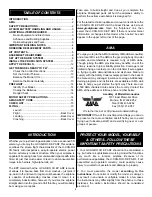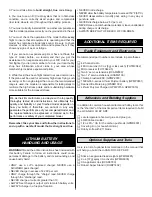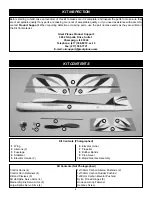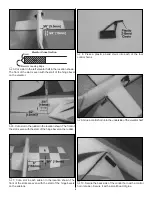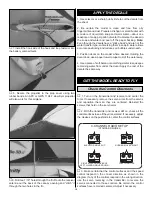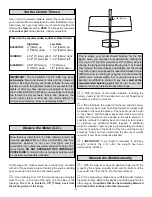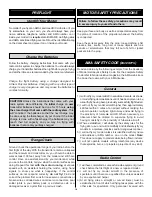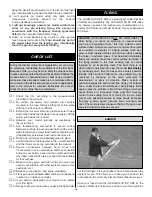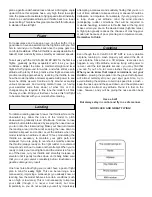
Use a ruler to accurately measure and set the control throw of
each control surface as indicated in the chart that follows. If your
radio does not have dual rates, we recommend setting the
throws at the high rate setting. NOTE: The throws are measured
at the widest part of the elevators, rudder and ailerons.
At this stage the model should be in ready-to-fly condition
with all of the systems in place including the engine, landing
gear, covering and paint, and the radio system.
❏
1. Use a felt-tip pen or 1/8" [3mm]-wide tape to accurately
mark the C.G. on the top of the wing on both sides of the
fuselage. The C.G. is located 2-7/8" [73mm] back from
the leading edge of the wing.
❏
2. With all parts of the model installed, including the
battery (ready to fly) lift it upside-down on your fingertips at
the balance point you marked.
❏
3. If the tail drops, the model is “tail heavy” and the battery
pack and/or receiver must be shifted forward or weight must
be added to the nose to balance. If the nose drops, the model
is “nose heavy” and the battery pack and/or receiver must be
shifted aft or weight must be added to the tail to balance. If
possible, relocate the battery pack and receiver to minimize
or eliminate any additional ballast required. If additional
weight is required, begin by placing incrementally increasing
amounts of weight on the bottom of the fuse until the model
balances. Once you have determined the amount of weight
required, it can be permanently attached.
❏
4. IMPORTANT: If you found it necessary to add any
weight, recheck the C.G. after the weight has been
permanently installed.
❏
1. With the wing level, have an assistant help you lift the
model by the engine propeller shaft and the bottom of the
fuse under the TE of the fin. Do this several times.
❏
2. If one wing always drops when you lift the model, it means
that side is heavy. Balance the airplane by adding weight to the
other wing tip. An airplane that has been laterally balanced
will track better in loops and other maneuvers.
Balance the Model Laterally
This is where your model should balance for the first
flights. Later, you may wish to experiment by shifting the
C.G. up to 1/2" [12.7mm] forward or 3/8" [9.5mm] back to
change the flying characteristics. Moving the C.G. forward
may improve the smoothness and stability, but the model
may then require more speed for takeoff and make it more
difficult to slow for landing. Moving the C.G. aft makes the
model more maneuverable, but could also cause it to
become too difficult to control. In any case, start at the
recommended balance point and do not at any time
balance the model outside the specified range.
2-7/8" [73mm]
More than any other factor, the C.G. (balance point) can
have the greatest effect on how a model flies, and may
determine whether or not your first flight will be
successful. If you value this model and wish to enjoy it for
many flights, DO NOT OVERLOOK THIS IMPORTANT
PROCEDURE. A model that is not properly balanced will
be unstable and possibly unflyable.
Balance the Model (C.G.)
IMPORTANT: The U-CAN-DO 3D EP ARF has been
extensively flown and tested to arrive at the throws at
which it flies best. Flying your model at these throws will
provide you with the greatest chance for successful first
flights. If, after you have become accustomed to the way
the U-CAN-DO 3D EP ARF flies, you would like to change
the throws to suit your taste, that is fine. However, too
much control throw could make the model difficult to
control, so remember, “more is not always better.”
These are the recommended control surface throws:
High Rate
Low Rate
ELEVATOR:
3" [76mm] up
1-1/2" [38mm] up
3" [76mm] down
1-1/2" [38mm] down
RUDDER:
4-1/2" [114mm] right 1-1/2" [38mm] right
4-1/2" [114mm] left
1-1/2" [38mm] left
AILERONS:
2-5/8" [67mm] up
1" [25mm] up
2" [51mm] down
7/8" [22mm] down
Set the Control Throws
13


